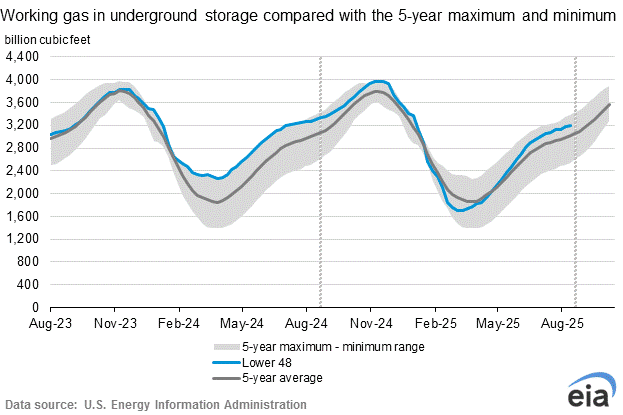Energy Markets Update
Weekly natural gas inventories
The U.S. Energy Information Administration reported last week that natural gas in storage increased by 98 Bcf. There was an injection for the same week last year of 95 Bcf while the five-year average injection is 92 Bcf. Total U.S. natural gas in storage stood at 2,411 Bcf last week, 13.7% less than last year and 2.2% lower than the five-year average for this time of year.
Nuclear retirements threaten climate goals
Following the conclusion of the PJM auction for the 2022-2023 commitment year, Exelon Generation reported that three of its nuclear power plants did not clear the auction, further jeopardizing Illinois’ nuclear sector and the state’s goal of 100% carbon-free electricity by 2050. PJM’s latest capacity auction, which can represent a significant revenue source for generation, resulted in a 64% decline in price from 2021/2022 to 2022/2023. The 2,346-MW Byron Generating Station, 1,805-MW Dresden and 1,819-MW Quad Cities nuclear plants failed to clear the auction, eliminating the potential revenue source altogether.
Byron and Dresden will retire this fall, despite having licenses to operate for another 20 years and 10 years, respectively. All plants had been awaiting a legislature stalemate that is deliberating hundreds of millions of dollars in subsidies meant to be deployed into Illinois’ nuclear sector. The Future Energy Jobs Act, which came into effect in 2017, will enable the Quads Cities plant to continue operating with an annual subsidy of $235 million, despite not clearing the capacity market. The two nuclear plants that did clear the market hold an aggregate 9,900 MW of nuclear power, and according to Exelon, carry some risk of “premature retirement” if Illinois legislation doesn’t provide material support to the sector.
The plants have faced hundreds of millions in revenue shortfalls due to declining electricity prices and an onslaught of new renewable energy capacity. Exelon also cited market rules that are unfavorable to nuclear and other low carbon resources, such as the Minimum Offer Price Rule (MOPR), as the reason behind Quad Cities’ reactor not clearing the market.
The six nuclear generation plants in Illinois account for about 65% of all the generation in the state and 12% of all nuclear generation in the U.S. The Byron and Dresden plants represent about 35% of the state’s nuclear capacity, so their loss is highly significant to both regional and federal climate goals.

Source: S&P
Despite carbon emission reduction being high on the national agenda, the retiring nuclear plants risk being replaced with natural gas-fired generation due to lower costs. Biden’s $2 trillion infrastructure plan to decarbonize the grid by 2035 indicated plans to support nuclear tax credits of $15/MWh for existing plants in deregulated power markets in an effort to push developers away from the financial gravity of fossil fuel sources in the market.
RI bill would drastically increase state RPS
Rhode Island Senate Bill 629, which would require 100% renewable energy by 2030, is making headway in the state’s legislature. The amendment to RI’s Renewable Energy Standard (RES) represents a significant increase from the previous statewide target of 38.5% renewable energy by 2035. RES compliance does not involve the physical procurement of power produced by renewable energy facilities. Instead, electricity providers meet the requirements of the RES mandate by purchasing renewable energy certificates (RECs), which represent 1 MWh of renewable energy generated and delivered to the electric grid. While this bill has not been signed into law, the Democratic-majority House’s review of the legislation holds a positive outlook on the bill’s approval. If passed, this bill would drastically catalyze the state’s renewable portfolio standard with power prices expected to take on a bullish demeanor and lift REC prices for the region. Preliminary estimates anticipate an increase of as much as 10% in RI electric commodity costs over the first five years of the law.
Natural Gas Storage Data


Market Data
Use the filters to sort by region
Market data disclaimer: Data provided in the "Market Data" section is for the newsletter recipient only, and should not be shared with outside parties.



